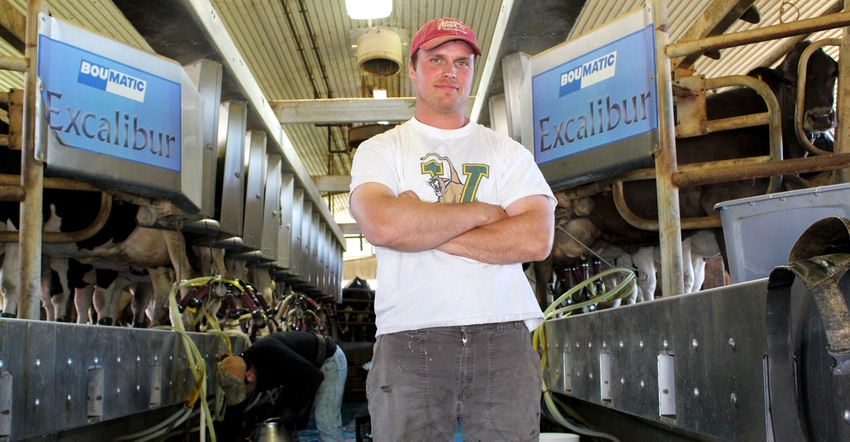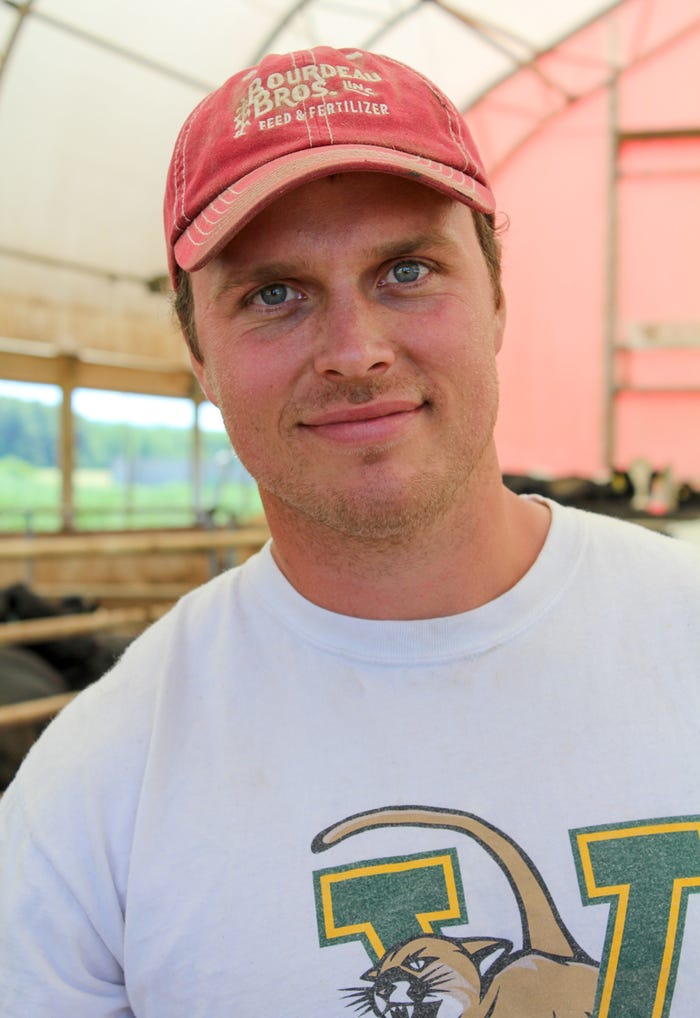September 13, 2018

Tile drainage is helping keep Nick Manning's farm solvent for years to come.
Manning, along with his brother, father and grandfather, milks 500 cows and raises 450 acres of corn and 450 acres of hay in Swanton, Vt.
The farm is rocky and fairly flat, with a variety of soil types. Manning's grandparents tiled the home farm about 30 years ago. Since then, the Mannings have purchased a neighboring 200-acre farm that they've been systematically tiling, too, using a commercial company.
"We level the field to get it flat and fill in the holes. The company GPS-maps the whole field and plan where tiling outlets go, the spacing and size of tile," Manning says.
Results speak for themselves
"Fields are definitely a lot drier. There are better and more even yields across the field," he says. "Now, with extreme weather patterns with bigger storms, it floods more, and the tile gets the water out of there faster, so hay dries out faster."
This summer's dry weather meant that the tile system didn't have to work too hard. But in an average year, tile drainage keeps the soils moist enough for crop growth but not so saturated they can't retain water when it rains, allowing it to slowly filter into the soil and out through a tile line. "That captures most of the phosphorus and prevents it from running into rivers," he says. "If you don't have drainage tile, then the soil can only hold so much water and the excess will run off the surface into waterways. Surface runoff is the biggest pathway for phosphorus entering waterways, which is what we are trying to reduce by using drainage tile."
Farmers like Manning are well-aware of the need to reduce nutrient runoff. Swanton, in the Lake Champlain Valley, borders Missisquoi Bay, which is plagued with phosphorus overload and algae blooms.
Good for alfalfa
Well-drained soils are also essential to growing alfalfa, an integral part of the Manning herd's diet and grown in rotation with corn.
"Alfalfa wouldn't last more than a year without tile," he says. "With system-tiled fields we can keep the water table at a suitable level for alfalfa, which allows us to grow pure alfalfa stands. Most alfalfa fields on nontiled land have to be seeded with a grass so that, when the alfalfa dies, the grass will grow in that spot."
Tile drainage is an important piece of the no-till system on the farm.
"I can get on a field earlier and, especially with no-till, you don't plow it. It holds water longer, so the tile helps. And as long as you have a good field, there's not a big yield difference," he says.
Manning estimates a four- to five-year payback on putting in a tiling system, depending on the condition of the individual field.
"In some places, we're bringing land into production that we couldn't do anything with before," he says.
Thumbs up for cover crops
Planting cover crops is another essential practice in his system.
"Cover crops soak up whatever nutrients are there after the corn crop is off," Manning says. "They help to reduce nitrogen losses by taking up the excess nitrogen in the soil and holding it in the plant until it's killed the following year and released back into the soil. And then when the dead plant releases that nitrogen, there is another growing crop to utilize it."
Cover crops also prevent some wheel rutting from equipment running on bare ground. The Mannings surface-apply most of their liquid manure in the spring and fall, and inject a small number of acres with manure, which they hope to increase in the future.
Manning has been interseeding cover crops the past few years. It's still a work in progress.
"Some years it works and some years it doesn't," he says.
This year, for example, the dry weather kept interseeding at a minimum, but Manning chose a drill over a highboy for the crops he did interseed.
"The drill seems to get more consistent plant growth, I believe, because when it's in the ground it's able to have more access to moisture than ... just sitting on top of the soil," he says.
 YOUNG FARMER: Nick Manning milks 500 cows and farms 450 acres in Swanton, Vt., with his father and grandfather.
YOUNG FARMER: Nick Manning milks 500 cows and farms 450 acres in Swanton, Vt., with his father and grandfather.

Manning likes interseeding because it gives him a wider choice of crops to plant after harvest. He's tried a mix of tillage radish, clover and rye; interseeded at top-dressing time; and has found that planting less radishes, which sprout a quick canopy, works better.
Manning has had to improvise because of the hot, dry weather. He plans to chop corn silage early and then drill triticale into no-till fields to harvest next spring as an additional feed source for his cows. "The most important part of fall-seeding triticale is to get it planted early enough so that it can get adequate growth in the fall before a killing frost," he says. "On a normal year it is hard to get it planted early enough."
Manning experimented with six different closing wheels on the cover crop planter to prevent seed from drying out. All the wheels worked well, he says, probably because soil conditions were ideal at planting and afterward. Next year he plans to be involved in a University of Vermont study to assess cover crop interseeding in different corn varieties. For example, corn varieties with more vertical leaf growth may allow more sun onto cover crops, but the varieties must first have good digestibility and milk production.
RAPs are acceptable, for now
Manning says that proposed amendments covering tile drainage to the state's Required Agricultural Practices aren't too onerous.
The proposed tile drainage amendment was accepted by the secretary of state in late August and has been sent to the Legislative Committee on Administrative Rules, which held a hearing Sept. 6.
The amendment prohibits farmers from locating concentrated feeding areas and feedlots over subsurface tiles. Also, new vegetative treatment areas for farm wastes can't be installed within 200 feet upslope of a subsurface tile drain, and new subsurface drainage can't be installed within 200 feet downslope of an existing vegetative treatment area.
It also requires farms with soil phosphorus levels above 20 parts per million to implement practices to reduce phosphorus and apply nutrients on fields with "pattern tile drainage" at less than the phosphorus crop nutrient removal rates from the University of Vermont.
After Jan. 1, rodent guards must be installed at the outlets of tile drainage systems.
About the Author(s)
You May Also Like




